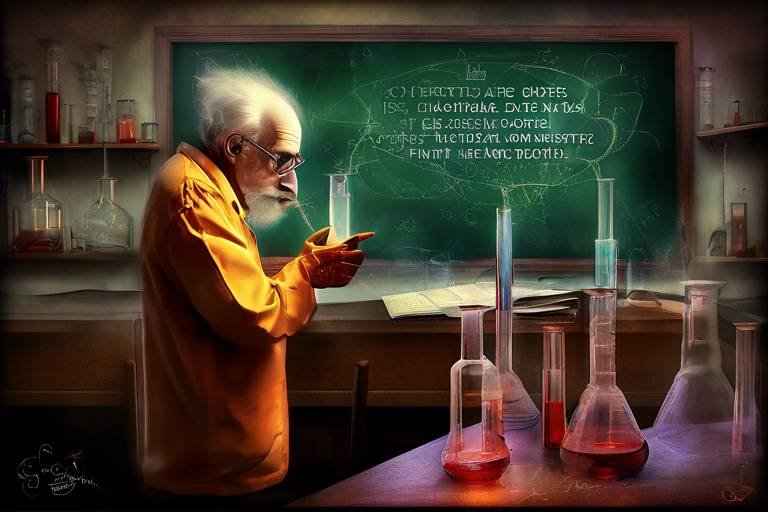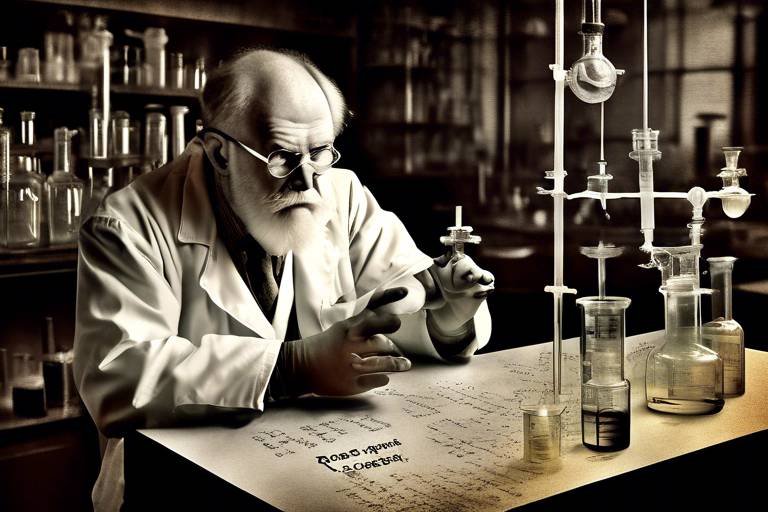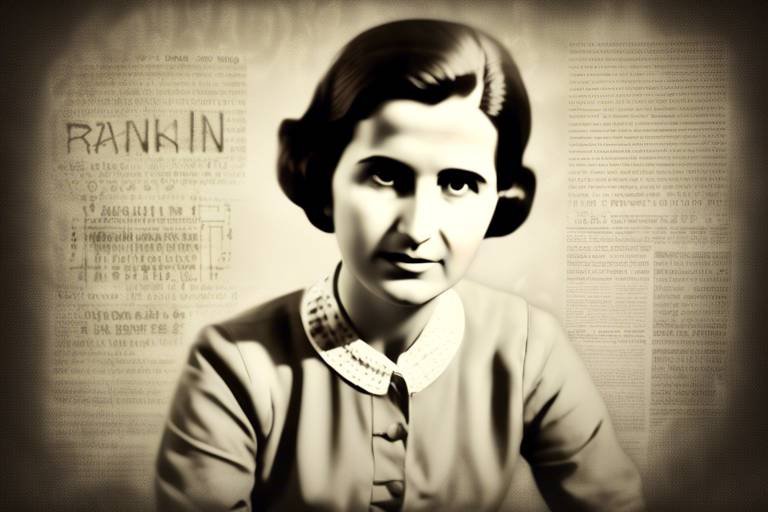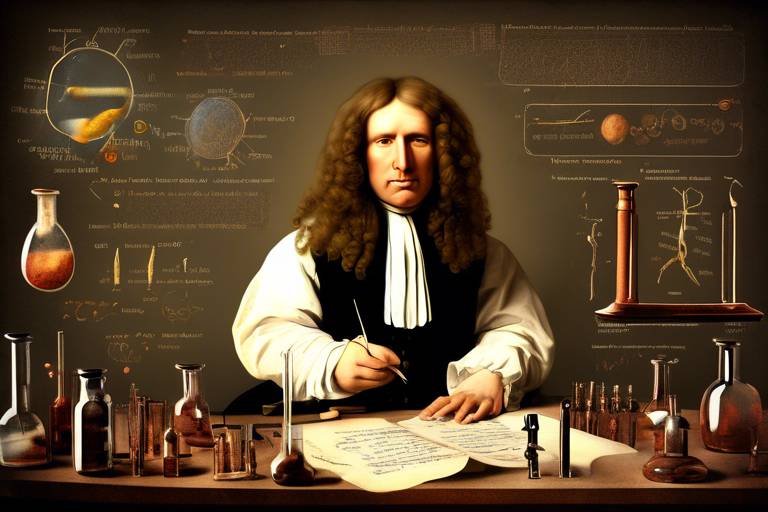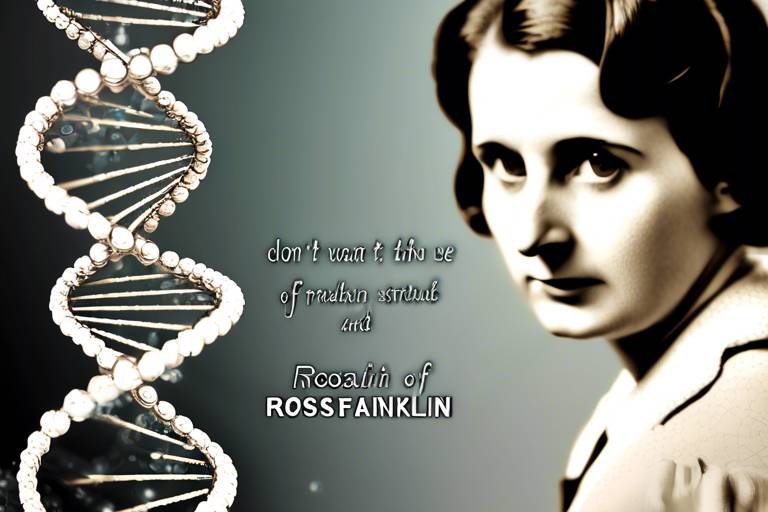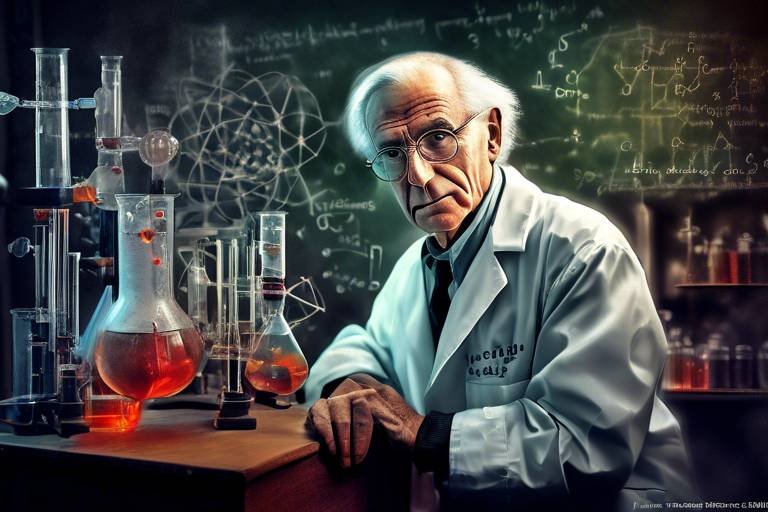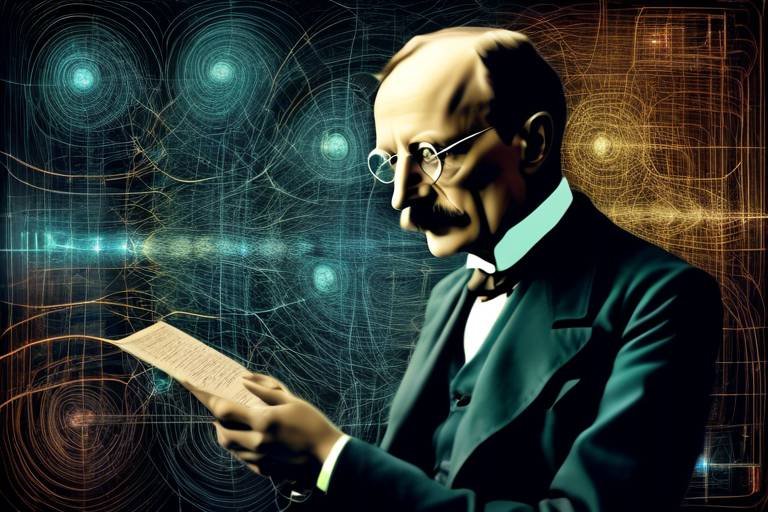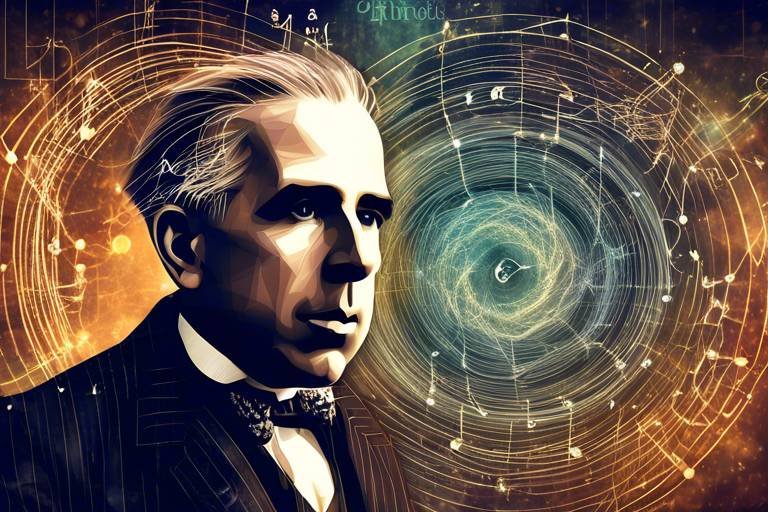The Discoveries of Louis Pasteur and Vaccines
Welcome to the fascinating world of Louis Pasteur, a name synonymous with groundbreaking discoveries that changed the landscape of science and public health forever. Born in 1822 in Dole, France, Pasteur wasn't just a scientist; he was a visionary who dared to challenge the status quo, transforming our understanding of microorganisms and their role in health and disease. His work has paved the way for the development of vaccines that have saved countless lives, making him one of the most revered figures in the history of medicine.
At the heart of Pasteur's legacy lies his dedication to unraveling the mysteries of life at the microscopic level. Imagine a world where diseases were thought to be caused by bad air or imbalances in bodily humors. Pasteur's relentless curiosity and innovative experiments shattered these misconceptions, laying the groundwork for modern microbiology. Through his studies, he not only advanced scientific knowledge but also improved public health practices that continue to benefit society today.
As we delve deeper into Pasteur's life and work, we will explore the remarkable journey that led him to formulate the germ theory of disease, conduct key experiments that changed scientific thought, and develop the process of pasteurization. We'll also discuss his pioneering efforts in the field of vaccination, including his groundbreaking rabies vaccine, which exemplified his innovative approach to immunization. So, buckle up as we take a closer look at the incredible contributions of Louis Pasteur and how they continue to impact our lives.
Louis Pasteur was born into a humble family, and from an early age, he displayed a keen interest in the sciences. His educational journey began at the local primary school and progressed to the prestigious École Normale Supérieure in Paris, where his passion for chemistry and biology flourished. Pasteur's early career was marked by a series of significant achievements, including his work on crystallography, which laid the foundation for his later discoveries in microbiology. With a mix of determination and innovation, he navigated the challenges of his time, ultimately becoming a leading figure in science.
Pasteur's formulation of the germ theory of disease was a revolutionary breakthrough that fundamentally changed our understanding of how diseases are caused. Prior to his work, many believed that diseases were caused by "miasmas" or bad air. However, Pasteur's meticulous research revealed that microscopic organisms, or germs, were responsible for various infections. This realization was akin to flipping a light switch in a dark room; suddenly, the invisible world of bacteria and viruses was illuminated, allowing for more effective prevention and treatment strategies.
One of Pasteur's most famous experiments involved the use of swan-neck flasks. He designed these flasks to demonstrate that microorganisms in the air were responsible for spoilage and disease. By boiling broth in the flasks and allowing them to cool, he found that dust and germs could not enter the curved necks, keeping the broth free from contamination. This experiment was a game-changer, challenging long-held beliefs and proving that sterilization could prevent microbial growth.
In addition to his work on disease, Pasteur made significant contributions to the field of fermentation. His research revealed that yeast was responsible for converting sugars into alcohol, a discovery that not only advanced the brewing and wine industries but also provided critical insights into microbial activity. This understanding of fermentation processes had profound implications for food safety and preservation, helping to ensure that the food we consume is safe and free from harmful pathogens.
Building on his fermentation research, Pasteur developed the process known as pasteurization. This method involves heating food and beverages to a specific temperature to kill harmful bacteria without compromising quality. The introduction of pasteurization has significantly improved food safety standards, reducing the incidence of foodborne illnesses and making it a crucial practice in the food industry. Today, pasteurization is a standard procedure for milk, juices, and various other products, ensuring that consumers enjoy safer options.
Perhaps one of Pasteur's most notable achievements was his pioneering work in the field of vaccines. His research led to the development of the rabies vaccine, a groundbreaking innovation that showcased his forward-thinking approach to immunization. By exposing animals to weakened forms of the virus, Pasteur demonstrated that it was possible to stimulate the immune system and provide protection against future infections. This innovative technique laid the groundwork for modern vaccination practices, saving countless lives and preventing the spread of deadly diseases.
Louis Pasteur's contributions to microbiology are immeasurable. His findings not only influenced his contemporaries but also inspired generations of scientists to explore the microscopic world. The establishment of microbiology as a crucial discipline in health sciences can largely be attributed to his work. Today, researchers continue to build upon Pasteur's discoveries, furthering our understanding of infectious diseases and developing new strategies for prevention and treatment.
Pasteur's legacy is evident in the modern vaccination programs that have successfully eradicated diseases such as smallpox and polio. These programs, rooted in Pasteur's principles of immunization, have played a vital role in promoting global health and preventing outbreaks. Vaccination not only protects individuals but also contributes to herd immunity, safeguarding entire communities from the spread of infectious diseases.
The spirit of innovation that Pasteur embodied continues to thrive in the field of vaccine development. Ongoing research inspired by his work is crucial in combating emerging infectious diseases. Scientists are constantly exploring new vaccine technologies, such as mRNA vaccines, which have gained prominence in recent years. This commitment to research and innovation ensures that we remain one step ahead in the fight against infectious diseases, just as Pasteur envisioned.
- What was Louis Pasteur's most significant contribution to science? Pasteur's most significant contribution was the formulation of the germ theory of disease, which revolutionized our understanding of how diseases are caused.
- How did Pasteur's work impact food safety? Pasteur developed the pasteurization process, which kills harmful bacteria in food and beverages, significantly improving food safety standards.
- What role did Pasteur play in the development of vaccines? Pasteur pioneered the development of vaccines, including the rabies vaccine, laying the groundwork for modern immunization practices.
- Why is Louis Pasteur considered a key figure in microbiology? Pasteur's research established microbiology as a crucial discipline in health sciences, influencing future scientists and advancing our understanding of infectious diseases.

The Life of Louis Pasteur
Louis Pasteur, a name synonymous with groundbreaking scientific achievements, was born on December 27, 1822, in Dole, France. Growing up in a modest family, Pasteur's early life was marked by the values of hard work and perseverance. His father, a tanner, instilled in him a strong sense of discipline, which would later become a cornerstone of his scientific endeavors. As a child, Pasteur exhibited a keen interest in the natural world, often exploring the countryside and observing the intricacies of nature. This curiosity would eventually lead him to pursue a career in science.
Pasteur's academic journey began at the École Normale Supérieure in Paris, where he studied chemistry and physics. His time at this prestigious institution was pivotal, as it not only honed his scientific skills but also exposed him to the vibrant intellectual community of the time. After completing his studies, Pasteur took on various teaching positions, which allowed him to delve deeper into research. It was during this period that he began to question established scientific beliefs, laying the groundwork for his future discoveries.
In the 1850s, Pasteur's career took a significant turn when he became involved in the study of fermentation. His research on the fermentation process in beverages like wine and beer led him to uncover the role of microorganisms in these transformations. This work not only advanced the brewing industry but also sparked his interest in the relationship between microbes and disease. Pasteur's ability to connect seemingly unrelated scientific fields showcased his innovative thinking and set the stage for his later breakthroughs in microbiology.
Throughout his life, Pasteur faced numerous challenges, including skepticism from his peers and personal tragedies, such as the death of his beloved daughter. However, these hardships only fueled his determination to succeed. He famously stated, “Science knows no country, because knowledge belongs to humanity, and is the torch which illuminates the world.” This perspective drove him to dedicate his life to research that would ultimately save millions of lives.
Pasteur's contributions to science were not without recognition. He became a member of the French Academy of Sciences and received numerous awards for his work. His relentless pursuit of knowledge and unwavering commitment to public health solidified his legacy as one of the greatest scientists in history. Today, we remember him not just for his discoveries, but for his profound impact on the fields of microbiology and immunology.
In summary, Louis Pasteur's life was a remarkable journey of curiosity, resilience, and groundbreaking discoveries. His early experiences shaped his scientific pursuits, leading him to challenge existing beliefs and revolutionize our understanding of disease and health. As we continue to benefit from his work, it is essential to recognize the man behind the science—a dedicated individual whose legacy continues to inspire future generations.

The Germ Theory of Disease
The germ theory of disease, a monumental leap in scientific understanding, was primarily articulated by Louis Pasteur in the 19th century. Before this revolutionary concept took hold, the prevailing belief was that diseases were caused by imbalances in bodily fluids or "bad air." Pasteur's research fundamentally shifted this perspective, laying the groundwork for modern medicine. Imagine a world where the cause of illness was a mystery—a world where people believed that diseases floated through the air like invisible ghosts. Pasteur's work helped to unveil the truth, revealing that these 'ghosts' were actually microscopic organisms.
Through meticulous experimentation, Pasteur demonstrated that specific microorganisms were responsible for specific diseases. This was not just a theoretical assertion; he backed it up with compelling evidence. His findings highlighted that bacteria could infect healthy organisms, leading to illness, and that controlling these microorganisms could prevent disease. This was a game-changer! It opened the door to a new understanding of hygiene practices, sanitation, and the importance of cleanliness in preventing illness.
One of Pasteur's most famous experiments involved the use of a swan-neck flask. He filled a flask with nutrient broth and then heated it to kill any existing microorganisms. The flask was designed with a long, curved neck that allowed air in but prevented dust and other particles from entering. Over time, he observed that the broth remained clear, indicating that no microbial growth occurred. However, when he broke the neck of the flask, exposing the broth to the air, it quickly became cloudy with microbial life. This simple yet profound experiment demonstrated that microorganisms in the air were responsible for contamination, challenging the long-held notion of spontaneous generation.
Pasteur's experiments didn't just stop at the lab bench; they had real-world implications, particularly in the fields of fermentation and food safety. His work showed that understanding germs could lead to better practices in food production and preservation. For instance, he discovered that controlling fermentation processes could prevent spoilage and improve the quality of products like wine and beer.
Pasteur's insights into fermentation were nothing short of revolutionary. Before his work, many brewers and winemakers relied on trial and error, often leading to inconsistent quality. With Pasteur's understanding of microbial activity, they could now control the fermentation process, ensuring that the right microorganisms were present. This not only improved the taste and safety of alcoholic beverages but also paved the way for advancements in various food industries.
One of the most significant outcomes of Pasteur's research was the development of the pasteurization process, a method that involves heating food and beverages to kill harmful bacteria without compromising quality. This process has become a cornerstone of food safety, significantly reducing the incidence of foodborne illnesses. Imagine being able to enjoy your favorite dairy products or juices, knowing that they have been treated to eliminate dangerous pathogens. Thanks to Pasteur, this is a reality!
In summary, the germ theory of disease not only transformed our understanding of health and illness but also revolutionized practices across various industries. Pasteur's groundbreaking work has saved countless lives and continues to influence modern medicine and public health policies today.

Key Experiments
Louis Pasteur’s journey into the world of microbiology is punctuated by a series of groundbreaking experiments that not only challenged the scientific norms of his time but also laid the foundation for modern medicine. One of his most famous experiments is the swan-neck flask experiment, conducted in the 1860s. This experiment was pivotal in demonstrating that microorganisms were responsible for spoilage and disease, effectively debunking the widely accepted theory of spontaneous generation—the idea that life could arise from non-living matter.
In this experiment, Pasteur took a series of flasks, filled them with nutrient broth, and then boiled them to kill any existing microorganisms. He designed the flasks with long, curved necks that allowed air to enter but prevented dust and microbes from contaminating the broth. The results were astonishing: the broth in the straight-necked flasks became cloudy with microbial growth, while the broth in the swan-necked flasks remained clear. This simple yet elegant demonstration provided compelling evidence that microorganisms in the air were responsible for contamination, and it was not a spontaneous generation of life.
Another significant experiment involved the study of fermentation. Pasteur's investigations into the fermentation process revealed that it was not just a chemical reaction but a biological one, driven by yeast and bacteria. He discovered that different microorganisms produced different fermentation products, leading to the understanding that specific microbes could be harnessed for specific purposes, such as brewing beer or fermenting wine. This knowledge not only advanced the brewing and wine industries but also provided critical insights into microbial activity that had implications for health and disease.
Furthermore, Pasteur's work on the development of vaccines stemmed from his experimental approach. His experiments with the anthrax bacterium and the rabies virus showcased his innovative methods. For instance, when developing the rabies vaccine, Pasteur used a technique of attenuation, where he weakened the virus so that it could stimulate an immune response without causing the disease. This method was revolutionary and opened up new avenues for immunization against various infectious diseases.
In summary, Pasteur's key experiments were not merely academic exercises; they were transformative actions that reshaped our understanding of microbiology and public health. His meticulous attention to detail and innovative experimental designs challenged existing paradigms and provided the scientific community with the tools necessary to combat infectious diseases. The implications of his work continue to resonate today, underscoring the importance of rigorous scientific inquiry in the pursuit of knowledge.
- What was the significance of the swan-neck flask experiment?
It demonstrated that microorganisms in the air were responsible for contamination, disproving the theory of spontaneous generation. - How did Pasteur's work influence the brewing industry?
His studies on fermentation revealed the role of specific microorganisms, allowing brewers to control the fermentation process for better quality products. - What is attenuation in vaccine development?
Attenuation is the process of weakening a virus so it can stimulate an immune response without causing the disease itself.

Impact on Fermentation
Louis Pasteur's work on fermentation was nothing short of revolutionary, fundamentally altering our understanding of how microorganisms interact with food and beverages. Before Pasteur, the processes of fermentation were shrouded in mystery, often attributed to spontaneous generation or divine intervention. However, Pasteur's meticulous research uncovered the true nature of fermentation, demonstrating that it was driven by living organisms—specifically, yeast and bacteria. This revelation not only changed the way we produce alcoholic beverages but also laid the groundwork for significant advancements in food safety and preservation.
One of Pasteur's most notable contributions was his discovery that different microorganisms are responsible for different types of fermentation. For instance, he identified that yeast is essential for converting sugars into alcohol, while lactic acid bacteria are responsible for the souring of milk and the fermentation of vegetables. This understanding allowed brewers and vintners to harness these microorganisms deliberately, leading to more consistent and higher-quality products. Imagine the difference between a haphazardly brewed beer and one crafted with precision, knowing exactly which yeast strain to use—this was the transformation Pasteur facilitated.
Moreover, Pasteur's insights into fermentation extended beyond the realm of beverages. His research helped improve the production of various foods, such as bread and cheese, by controlling fermentation processes to enhance flavor and texture. The implications of his work were vast, as they not only improved the quality of food but also contributed to food safety by reducing spoilage and the risk of foodborne illnesses.
To illustrate the impact of Pasteur's work on fermentation, consider the following table that highlights key fermentation processes and their associated microorganisms:
| Fermentation Type | Microorganism | End Product |
|---|---|---|
| Alcoholic Fermentation | Yeast (Saccharomyces cerevisiae) | Alcohol (Ethanol) |
| Lactic Acid Fermentation | Lactic Acid Bacteria (Lactobacillus) | Lactic Acid |
| Acetic Acid Fermentation | Acetic Acid Bacteria (Acetobacter) | Vinegar |
In summary, the impact of Pasteur's research on fermentation cannot be overstated. His findings not only advanced the brewing and food industries but also provided critical insights into microbial activity and its implications for health. By understanding the role of microorganisms in fermentation, we have been able to improve food safety, enhance flavors, and create a wide variety of products that are staples in our diets today. Pasteur's legacy in this field continues to influence modern practices, ensuring that we enjoy safe and delicious food and beverages.
- What was Louis Pasteur's most significant contribution to fermentation? Pasteur's most significant contribution was demonstrating that fermentation is caused by specific microorganisms, leading to improved methods in brewing and food production.
- How did Pasteur's discoveries affect food safety? His work helped reduce spoilage and the risk of foodborne illnesses by understanding and controlling the fermentation process.
- What are some common products that result from fermentation? Common products include beer, wine, yogurt, cheese, and vinegar, all of which rely on specific microorganisms to develop their unique flavors and textures.

Pasteurization Process
The is one of Louis Pasteur's most significant contributions to public health and food safety. Imagine a world where milk, juice, and other perishable items could spoil overnight, leading to widespread illness and foodborne diseases. This was the reality before Pasteur's groundbreaking work in the 19th century. By applying heat to food and beverages, Pasteur discovered a method to kill harmful microorganisms without compromising the quality of the product. This revolutionary technique not only extended the shelf life of various foods but also made them much safer for consumption.
At its core, pasteurization involves heating liquids to a specific temperature for a set period of time, followed by rapid cooling. This process effectively eliminates pathogens that cause diseases, such as Salmonella and E. coli. The standard temperature and time for pasteurization can vary depending on the product being treated. For example, milk is typically heated to about 161°F (72°C) for at least 15 seconds, while fruit juices may require different parameters. The beauty of pasteurization lies in its ability to maintain the nutritional value and flavor of the food while ensuring safety.
To better understand the effectiveness of pasteurization, consider the following table that highlights various products and their pasteurization conditions:
| Product | Temperature | Time |
|---|---|---|
| Milk | 161°F (72°C) | 15 seconds |
| Fruit Juice | 160°F (71°C) | 1 minute |
| Canned Vegetables | 240°F (116°C) | 20-30 minutes |
Pasteur's method not only revolutionized the food industry but also played a pivotal role in public health. By significantly reducing the incidence of foodborne illnesses, pasteurization has saved countless lives and has become a standard practice worldwide. Today, pasteurization is not limited to dairy products; it has expanded to include a variety of liquids and even some solid foods. This widespread adoption showcases the lasting impact of Pasteur's innovative thinking.
Moreover, pasteurization has paved the way for further advancements in food preservation techniques. As we continue to explore new methods to ensure food safety, the foundational principles established by Pasteur remain relevant. In a world where food safety is more crucial than ever, understanding the pasteurization process is essential for both consumers and producers alike.
In conclusion, the pasteurization process exemplifies how a simple yet effective technique can transform an entire industry. Louis Pasteur's legacy lives on through the safe consumption of food and beverages, making our lives healthier and more secure. As we enjoy our daily glass of milk or freshly squeezed juice, we can appreciate the ingenuity of a man who changed the course of food safety forever.
- What is pasteurization? Pasteurization is a heat treatment process that kills harmful microorganisms in food and beverages to make them safe for consumption.
- Who invented pasteurization? Pasteurization was developed by Louis Pasteur in the 19th century as a method to improve food safety.
- What foods are commonly pasteurized? Commonly pasteurized foods include milk, fruit juices, and canned vegetables.
- Does pasteurization affect the nutritional value of food? No, pasteurization is designed to retain the nutritional value and flavor of food while ensuring safety.

Vaccination Breakthroughs
Louis Pasteur’s contributions to the field of vaccination represent a monumental leap in the fight against infectious diseases. His innovative approach not only reshaped the understanding of how diseases spread but also laid the groundwork for the development of vaccines that would save countless lives. Imagine a world plagued by rabies, a disease that was once a death sentence; Pasteur's work transformed that narrative, offering hope and protection to countless individuals.
One of Pasteur’s most notable achievements was the creation of the rabies vaccine in 1885. This was not just a scientific triumph; it was a beacon of hope for humanity. Before Pasteur's intervention, rabies was a terrifying prospect, especially for those bitten by animals suspected of carrying the virus. The vaccine was developed through a meticulous process of attenuating the rabies virus, which involved drying the spinal cords of infected rabbits. This method, while groundbreaking, was also a testament to Pasteur's dedication and ingenuity in the laboratory.
But how did Pasteur’s work on the rabies vaccine change the landscape of vaccination? It was revolutionary in several ways:
- Scientific Rigor: Pasteur’s methods emphasized the importance of scientific experimentation and validation, paving the way for future vaccine development.
- Public Health Impact: The rabies vaccine significantly reduced the incidence of rabies, showcasing the potential of vaccines to prevent disease on a large scale.
- Immunization Concept: Pasteur introduced the concept of vaccination as a means of inducing immunity, which became foundational for future vaccines.
Following the success of the rabies vaccine, Pasteur continued to explore the potential of vaccines against other diseases. His work inspired a generation of scientists and laid the groundwork for the development of vaccines against diseases such as anthrax and chicken cholera. Each of these breakthroughs demonstrated the power of vaccination as a tool for public health, transforming how societies approached disease prevention.
In essence, Pasteur's pioneering spirit and relentless pursuit of knowledge not only provided solutions for his time but also set the stage for the future of immunization. Today, we owe much of our understanding of vaccines to his foundational work. The principles he established continue to guide researchers and healthcare professionals in their quest to combat infectious diseases.
As we reflect on the remarkable journey of vaccination, it’s crucial to recognize that the breakthroughs achieved by Pasteur were not merely scientific victories; they were lifelines that connected us to a healthier future. His legacy lives on in the vaccines that protect millions around the globe, reminding us of the profound impact one individual can have on public health.
Q1: What was the first vaccine developed by Louis Pasteur?
A1: The first vaccine developed by Louis Pasteur was the rabies vaccine, created in 1885, which provided a method to prevent the disease after exposure.
Q2: How did Pasteur's work influence modern vaccines?
A2: Pasteur's work introduced the concept of vaccination as a means of inducing immunity, establishing methods for developing vaccines that are still in use today.
Q3: What diseases did Pasteur create vaccines for?
A3: Besides rabies, Pasteur developed vaccines for anthrax and chicken cholera, significantly impacting public health and disease prevention.
Q4: Why is Pasteurization important in relation to vaccines?
A4: Pasteurization, developed by Louis Pasteur, is crucial as it ensures the safety of biological products, including vaccines, by eliminating harmful microorganisms.

Legacy in Microbiology
Louis Pasteur's contributions to microbiology have left an indelible mark on science and public health. His pioneering work not only established the foundation for the field but also revolutionized how we understand and combat infectious diseases. Imagine a world where diseases were rampant, and the causes were shrouded in mystery; Pasteur stepped into that chaos and brought clarity. His formulation of the germ theory of disease transformed medicine, shifting the focus from miasmas and humors to the microscopic organisms that truly drive illness.
The impact of Pasteur's discoveries can be seen in various aspects of modern science and healthcare. For instance, his identification of pathogens as the culprits behind diseases led to the development of sterilization techniques that are now standard practice in hospitals and laboratories. This shift not only improved patient outcomes but also laid the groundwork for the entire field of microbiology. Today, microbiology is a critical discipline that informs our understanding of everything from antibiotic resistance to the human microbiome.
One cannot overlook the influence Pasteur had on future scientists. His meticulous approach to experimentation and emphasis on empirical evidence inspired generations of researchers. Figures such as Robert Koch, who furthered the germ theory with his own studies, built upon Pasteur's foundation. The ripple effects of Pasteur's work can be seen in the establishment of microbiology as a formal discipline, with dedicated departments in universities and research institutions worldwide.
Moreover, Pasteur's legacy extends beyond the laboratory. His commitment to public health and safety has had profound implications for society. Vaccination programs, which are a direct result of his pioneering work, have saved countless lives and eradicated diseases that once plagued populations. For instance, the rabies vaccine, developed by Pasteur, has not only prevented suffering but has also instilled confidence in vaccination as a means to control infectious diseases.
In addition to his scientific achievements, Pasteur's ability to communicate complex ideas to the public helped foster a greater understanding of microbiology and its relevance to everyday life. He recognized that science should not be confined to the ivory towers of academia; instead, it should be accessible and applicable to the broader community. This principle is crucial today as we face new challenges in public health, such as vaccine hesitancy and misinformation.
To summarize, Louis Pasteur's legacy in microbiology is profound and multifaceted. His groundbreaking discoveries opened the door to modern medicine and public health practices, influencing not only scientific research but also the way society approaches health challenges. As we continue to innovate and advance our understanding of microorganisms, we owe a debt of gratitude to Pasteur, whose vision and dedication have shaped the course of science for generations.
- What is the germ theory of disease? The germ theory of disease posits that many diseases are caused by microorganisms. This theory fundamentally changed how diseases are understood and treated.
- How did Pasteur contribute to the field of microbiology? Pasteur's experiments and discoveries laid the groundwork for microbiology as a scientific discipline, establishing the relationship between microorganisms and disease.
- What are some vaccines developed by Pasteur? Pasteur developed several vaccines, including those for rabies and anthrax, which have had a lasting impact on public health.

Modern Vaccination Programs
Modern vaccination programs are a testament to the revolutionary work of Louis Pasteur and his pioneering spirit in the field of immunology. Today, we see a world where vaccines are not just a preventive measure but a cornerstone of public health, significantly reducing the incidence of infectious diseases that once ravaged populations. The foundation laid by Pasteur has evolved into comprehensive vaccination strategies that are implemented globally, saving millions of lives each year.
Vaccination programs vary widely across different countries, tailored to meet the specific health needs of their populations. For instance, the World Health Organization (WHO) recommends a series of vaccines for children that include:
- BCG (Bacillus Calmette-Guérin) for tuberculosis
- DTaP (Diphtheria, Tetanus, and Pertussis) for childhood diseases
- MMR (Measles, Mumps, and Rubella) to combat these highly contagious diseases
- Polio vaccine to eradicate poliomyelitis
- Hepatitis B vaccine to prevent liver infection
These vaccines work by training the immune system to recognize and combat pathogens, providing immunity without causing the disease itself. The effectiveness of these programs can be seen in the dramatic decline in disease incidence. For example, the global incidence of measles has dropped by over 80% since the introduction of the MMR vaccine, showcasing the power of vaccination in action.
Moreover, modern vaccination programs are not static; they continuously adapt to emerging health threats. The recent global pandemic underscored the importance of rapid vaccine development and distribution. Scientists and health organizations rallied together to produce COVID-19 vaccines at an unprecedented pace, demonstrating the agility and responsiveness of modern vaccination strategies. This swift action has not only saved lives but has also highlighted the critical role of public health infrastructure in managing health crises.
As we look to the future, the legacy of Pasteur inspires ongoing research and innovation in vaccine technology. Scientists are exploring new platforms, such as mRNA vaccines, which offer a promising avenue for rapid development against various infectious diseases. This innovation could potentially reshape the landscape of vaccination, making it easier to respond to outbreaks and emerging pathogens.
In conclusion, modern vaccination programs are a direct reflection of the groundwork laid by Louis Pasteur. They are essential in promoting global health, preventing outbreaks, and ultimately saving lives. As we continue to build on his legacy, the focus remains on ensuring equitable access to vaccines for all, fortifying our defenses against existing and emerging infectious diseases.
Here are some common questions regarding modern vaccination programs:
- Why are vaccines important? Vaccines are crucial for preventing diseases, protecting individual health, and achieving herd immunity, which helps protect vulnerable populations.
- Are vaccines safe? Yes, vaccines undergo rigorous testing and monitoring for safety and efficacy before they are approved for public use.
- What is herd immunity? Herd immunity occurs when a significant portion of a population becomes immune to a disease, making its spread unlikely, thus protecting those who cannot be vaccinated.
- How do vaccines work? Vaccines stimulate the immune system to recognize and fight pathogens, preparing the body to respond effectively if exposed in the future.

Continued Research and Innovation
Louis Pasteur's pioneering work in microbiology and vaccination has paved the way for a multitude of advancements in the field, and his legacy continues to inspire scientists around the globe. Today, researchers are building on Pasteur's foundational discoveries to develop innovative vaccines and treatments that address both emerging and re-emerging infectious diseases. The landscape of vaccine development has evolved dramatically since Pasteur's time, driven by technological advancements and a deeper understanding of immunology.
For instance, the advent of molecular biology techniques has revolutionized the way vaccines are designed. Modern scientists can now manipulate genetic material to create more effective vaccines that not only stimulate a robust immune response but also provide longer-lasting protection. This approach has been instrumental in the rapid development of vaccines for diseases like COVID-19, where mRNA technology was utilized to create safe and effective vaccines in record time.
Moreover, the ongoing research into universal vaccines aims to provide broad protection against various strains of viruses, such as influenza. This innovation could potentially eliminate the need for annual vaccinations, making immunization more accessible and efficient. The quest for a universal vaccine is a testament to the enduring spirit of innovation that Pasteur ignited in the scientific community.
In addition to vaccine development, Pasteur's influence is evident in the realm of antimicrobial resistance. As bacteria evolve and become resistant to existing treatments, researchers are exploring novel approaches to combat these superbugs. This includes the development of bacteriophage therapy, which utilizes viruses that specifically target bacteria, offering a promising alternative to traditional antibiotics.
Furthermore, the global health landscape is increasingly interconnected, and with that comes the necessity for collaborative research efforts. International partnerships among scientists, healthcare professionals, and governments are crucial in addressing global health challenges. Initiatives like the Coalition for Epidemic Preparedness Innovations (CEPI) exemplify this collaborative spirit, focusing on accelerating vaccine development for infectious diseases that pose a significant threat to global health.
As we look to the future, the importance of continued research and innovation cannot be overstated. The challenges we face today—such as pandemics, climate change, and the rise of antibiotic-resistant bacteria—require a concerted effort from the scientific community. By embracing Pasteur's legacy of inquiry and experimentation, we can continue to push the boundaries of what is possible in the field of microbiology and public health.
| Research Areas | Current Innovations | Future Directions |
|---|---|---|
| Vaccine Development | mRNA Vaccines | Universal Vaccines |
| Antimicrobial Resistance | Bacteriophage Therapy | Novel Antimicrobials |
| Global Health Initiatives | CEPI Collaborations | International Research Networks |
In summary, the spirit of innovation that Louis Pasteur championed is alive and well in today's scientific endeavors. The ongoing research not only honors his legacy but also holds the promise of a healthier future for all. By continuing to push the boundaries of knowledge and technology, we can ensure that the fight against infectious diseases remains at the forefront of public health initiatives.
- What was Louis Pasteur's most significant contribution to science?
Pasteur is best known for developing the germ theory of disease and creating vaccines for rabies and anthrax, which laid the groundwork for modern microbiology and immunology.
- How has Pasteur's work influenced modern vaccines?
His principles of vaccination, particularly the concept of using weakened or inactivated pathogens to stimulate an immune response, are foundational to current vaccine development.
- What are some current challenges in vaccine development?
Challenges include addressing vaccine hesitancy, ensuring equitable access, and developing vaccines for rapidly mutating viruses.
Frequently Asked Questions
- What were Louis Pasteur's main contributions to science?
Louis Pasteur is best known for his groundbreaking work in microbiology, particularly the formulation of the germ theory of disease. He conducted pivotal experiments that demonstrated the role of microorganisms in spoilage and disease, laying the foundation for modern medicine. Additionally, his development of the pasteurization process and vaccines, including the rabies vaccine, has had a lasting impact on public health.
- How did Pasteur's work influence the field of vaccination?
Pasteur's innovative approach to immunization transformed the way we understand and prevent diseases. His work on vaccines, particularly the rabies vaccine, showcased the potential of vaccination as a powerful tool for disease prevention. This laid the groundwork for modern vaccination programs that have successfully eradicated or controlled numerous infectious diseases worldwide.
- What is pasteurization and why is it important?
Pasteurization is a process developed by Louis Pasteur that involves heating food and beverages to a specific temperature to kill harmful bacteria without compromising quality. This method significantly improved food safety, reducing the risk of foodborne illnesses and revolutionizing the food and beverage industry. Today, pasteurization is a standard practice that protects public health.
- Can you explain the germ theory of disease?
The germ theory of disease, formulated by Pasteur, posits that many diseases are caused by microorganisms. This theory challenged the prevailing miasma theory, which attributed illness to "bad air." Pasteur's research provided compelling evidence that specific pathogens are responsible for specific diseases, transforming medical practices and hygiene standards.
- What experiments did Pasteur conduct to support his theories?
One of Pasteur's most famous experiments was the swan-neck flask experiment. He demonstrated that sterilized broth remained free of microbial growth unless exposed to air, which contained microorganisms. This experiment was crucial in debunking spontaneous generation and solidifying the concept that microorganisms are responsible for spoilage and disease.
- How has Pasteur's legacy impacted modern science?
Louis Pasteur's legacy continues to influence modern science, particularly in microbiology and immunology. His discoveries have inspired countless scientists and led to advancements in vaccine development, infectious disease research, and public health initiatives. His work is a cornerstone of the scientific understanding of disease prevention and treatment.
- Are there ongoing research initiatives inspired by Pasteur's work?
Yes, ongoing research initiatives continue to build on Pasteur's foundational discoveries. Scientists are exploring new vaccine technologies, studying the microbiome, and developing innovative approaches to combat infectious diseases. Pasteur's pioneering spirit in research and innovation remains a guiding force in the scientific community.



